The 6th Century B.C was a time when men’s minds in several parts of the world were deeply stirred by the problem of religion and salvation. In India, this movement was active in the kingdom of Magadha. The ruling class, considered themselves better than their spiritual guides. Even the Brahmans were arrogant considering themselves superior to others.
This rebellion against the Brahmans caused many sects to be born, each advocating different opinions of the nature of God and and relation of God to Man. All of them died in time except two, Jainism and Buddhism. Both at one time pervaded almost every corner of India and enjoyed royal patronage. Buddhism unfortunately died out in India and is now confined to countries like Sri Lanka, Burma, Tibet, China and Japan. Judged by the posthumous effects on the world at large, The Buddha was the greatest man to be born ever in the Indian Sub Continent.
The story of Buddha and his life appears only in the later Buddhist scriptures but some of the references are totally unreliable. Certain details are very certain. He was the son of a Sakya chieftain and was named Siddhartha Gautama, became an ascetic at the age of 35 years, became a Buddha (The Enlightened) under a peepal tree, and died at the age of Eighty at Kushinagara. It is believed that he was seriously affected with dysentery after eating a meal of pork, served by a blacksmith. This could be true as it is said that Buddha advised his followers that eating meat is fine as long as the living beings have not been killed to serve the monks. His followers cremated him and his ashes were distributed among the rulers and elders of the local tribes.
Now the question comes, when and why sub-sects started in such a simple religion. At the second General Council at Vaisali, a hundred years after Gautama Buddha’s death, there was a big divide on monastic discipline and the Order split into Orthodox “Sthaviravadins” and “Mahasanghika”. These minor points of discipline were soon to follow by doctrinal differences of a very major importance, which in centuries to follow were the cause of a further more divide.
The Mahasanghika later was divided into Mahayana (The Great Vehicle) and Hinayana (The lesser one). The Mahayana was considered to be a path for Bodhisatvas to attain Buddhahood. In the early school of Buddhism, there was no idol worship. It was more of a symbol worship; the Bodhi Tree, an empty throne, foot marks which depicted Buddha, lotus flower, the wheel of Dharma etc. which depict various aspects of Siddhartha Gautama’s life. There was a time where the existence of Buddhism was in question. The Mahayana sect which were great in number had to pave way for Idol Worship. The idol worship was started by Acharya Nagarjuna, during the years 167 and 196 A.D when King Yajnasri was ruling the Satavahana Kingdom.
With an introduction to Buddhism, we talk more about the scriptures, sects and Buddhist art.
Planning for a 10 day trip was not easy. As always, the amount of reading was very deep and took almost a month. Choosing the places and route was again a challenge, which required a lot of travelling from one place to another. With a perfect itinerary, I started off. All accommodations were booked before.
Those 10 days were unforgettable. I travelled as if I was in air. Quick bites wherever I could find and liquids; Liquids kept me alive with all the marathon travelling, could be tea or water or soft drinks. Daulatabad was the most tiresome of treks, but very interesting understanding the history with a deep sense of psychological aspect of the construction of the Fort.
There were at times when I had to take a break for health reasons, because of which had to skip Sinhgad trek. Most memorable was roaming about Pune Streets, searching for a person whom I have never met and do not even know where he stays. It took 4 long hours of desperation and determination to meet the person, who enlightened me with little known facts which I shall write about in due course of time.
Lastly, a pleasant trip to Bhaja Caves with my wife (my fiancée then), a perfect ending to a straining journey.
It all started when I got down in Aurangabad at 2 AM in the night and started off with my journey. Before knowing about Aurangabad, I want to set the context with a little information on Buddhism and its Iconography in the forthcoming post.
It is somehow a surprising fact of Indian History that dynasties which were, at one time the greatest and path breakers have vanished in oblivion just like that. Even the places that had seen those days cease to be recognized. The Fort in Malkhed is one of such places from which the Rashtrakutas ruled.
The Rashtrakuta Empire ruled large parts of the Indian Subcontinent between the sixth and tenth Century A.D. However, their history can be traced till the 13th Century. The origin of this dynasty is a controversial topic, however, the Rashtrakutas of Manyakheta (our Malkhed) can be accurately traced by numerous contemporaneous inscriptions referring them. In fact many rulers, claimed to be Rashtrakutas at one point in time and ruled in parallel, parts of India. The crux of the empire extended from the Cauvery River in the South to the south of river Narmada on the North. At their peak, they were the only South Indian empire who conquered regions as far as Kannauj as well as extreme South. How can we forget the largest monolithic temple of the world, the Kailas Temple of Ellora? This was commissioned and built during the reign of Krishna I. Apart from multiple constructions in Ellora, Rashtrakutas contributed to Elephanta Caves and Cave Temples in Padatkal (Karnataka).
Malkhed became the capital city of Rashtrakutas during the rule of Amoghava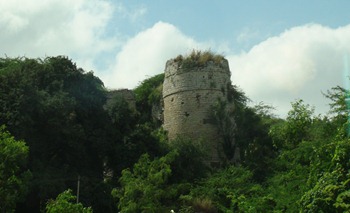 rsha I. This place was also the capital city of the Western Chalukyas till the end of 10th Century. Today, it is a barren land with traces of the brutally demolished glory. I came to know about this fort during my research before travelling and wanted to explore. I hired a vehicle to travel to Malkhed. 40 kilometers of bad roads, one hour of anticipation and a first visual of a huge bastion, I was extremely excited. Walls connect to the bastion and from outside, it looked like a brick structure with a coated layer. But on a close observation, it turned out to be crude sto
rsha I. This place was also the capital city of the Western Chalukyas till the end of 10th Century. Today, it is a barren land with traces of the brutally demolished glory. I came to know about this fort during my research before travelling and wanted to explore. I hired a vehicle to travel to Malkhed. 40 kilometers of bad roads, one hour of anticipation and a first visual of a huge bastion, I was extremely excited. Walls connect to the bastion and from outside, it looked like a brick structure with a coated layer. But on a close observation, it turned out to be crude sto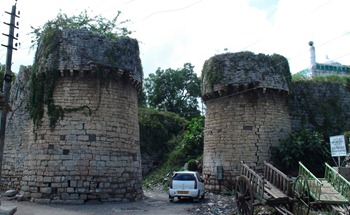 nes placed one upon the other.
nes placed one upon the other.
The entrance is massive with two large bastions on either side. There is a narrow design on the top of each bastion. Interestingly, this is also made of stone and fitted into the construction. Gaps in the stone structure are visible now and are in a very bad shape with no maintenance. 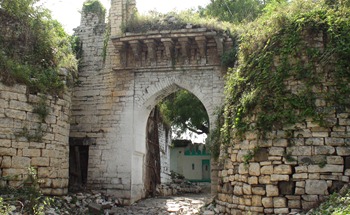 You can find a construction outside the entrance to the right which is recent but built off the stones inside the fort. As I moved inside I passed through one more gateway with smaller bastions on either side. This gateway has a small parapet with similar stone design as we had seen on the bastions of the main entrance. There is a small house inside this
You can find a construction outside the entrance to the right which is recent but built off the stones inside the fort. As I moved inside I passed through one more gateway with smaller bastions on either side. This gateway has a small parapet with similar stone design as we had seen on the bastions of the main entrance. There is a small house inside this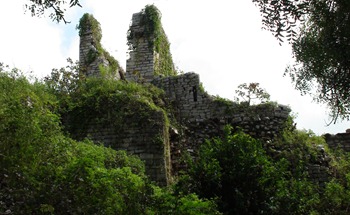 gateway being used by a Muslim family.
gateway being used by a Muslim family.
Once I passed through this house and turn right and walk through first visuals of the buildings appeared. I was astonished to see that they were all totally demolished with not even minimum maintenance. The entire walkway is filled with rubble and  stone. If you keenly observe, you can find walls on either side covered in bushes now. Such is the pathetic situation inside. You will find broken structures here and there. There is no way I could understand what kind of structures they were and what was their significance. I walked almost 300 meters further when I saw
stone. If you keenly observe, you can find walls on either side covered in bushes now. Such is the pathetic situation inside. You will find broken structures here and there. There is no way I could understand what kind of structures they were and what was their significance. I walked almost 300 meters further when I saw 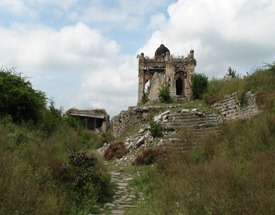 a small domed structure with an entrance at a distance. There is a flight of steps to reach this structure. The top of the entrance, made of brick and mortar is broken in the middle and can collapse any day. The entrance apparently was well decorated with minute carvings but none of it is clear.
a small domed structure with an entrance at a distance. There is a flight of steps to reach this structure. The top of the entrance, made of brick and mortar is broken in the middle and can collapse any day. The entrance apparently was well decorated with minute carvings but none of it is clear.
 Inside is a small domed mantapa with a broken parapet, decorated though. I carefully went inside. As expected, many parts of this structure are broken and lying here and there. There are three arches through which one can enter inside. The building is supported by 8 pillars within and three internal arches of the same style. The dome is decorated with an octagonal design. Finding that I do not have anything to see inside this mantapa, I proceed further to another small construction in this vicinity.
Inside is a small domed mantapa with a broken parapet, decorated though. I carefully went inside. As expected, many parts of this structure are broken and lying here and there. There are three arches through which one can enter inside. The building is supported by 8 pillars within and three internal arches of the same style. The dome is decorated with an octagonal design. Finding that I do not have anything to see inside this mantapa, I proceed further to another small construction in this vicinity.
Once I got near the other construction, I understood that it was a Jaina 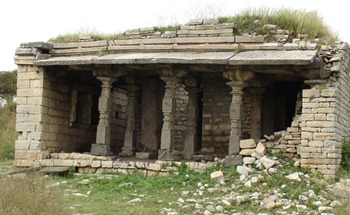 basadi. We always knew that Rashtrakutas as great patrons of the Jain religion. However, this is the only indication that I found inside the fort. This is a typical basadi with simple design. The posterior part of the basadi, the sanctum was reconstructed in recent times. By the looks it is difficult to identify the idol inside, but by the simplicity I am assuming it to be Adinatha or Shantinatha who were the foremost Tirthankaras. Also, the later Tirthankaras had typical identifiers which are not present in this one.
basadi. We always knew that Rashtrakutas as great patrons of the Jain religion. However, this is the only indication that I found inside the fort. This is a typical basadi with simple design. The posterior part of the basadi, the sanctum was reconstructed in recent times. By the looks it is difficult to identify the idol inside, but by the simplicity I am assuming it to be Adinatha or Shantinatha who were the foremost Tirthankaras. Also, the later Tirthankaras had typical identifiers which are not present in this one.
 There is a further road to the side of this basadi and I walked. It was a short but tiresome walk uphill. Further down, I came across a domed building again which I could not understand its importance. Considering the pitiable condition in which this place is, it is high time the authorities strive to do a face lift of the entire place and who knows, there might be unknowns waiting to be explored.
There is a further road to the side of this basadi and I walked. It was a short but tiresome walk uphill. Further down, I came across a domed building again which I could not understand its importance. Considering the pitiable condition in which this place is, it is high time the authorities strive to do a face lift of the entire place and who knows, there might be unknowns waiting to be explored.
When Amoghavarsha started ruling from Malkhed, he was already old and became a follower of the Digambara sect of Jainism. This could be a reason why the defenses of this fort look very weak. Even though the rulers were peace lovers, they frequently ventured into provoked battles and continued their legacy for the next 250 years without being defeated.
Manyakheta was plundered sometime after 1050 A.D and the dynasty was taken over the Chalukyas of Kalyani.




